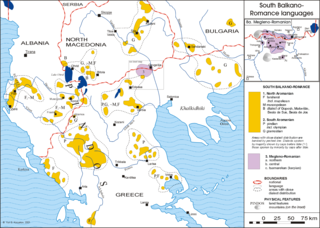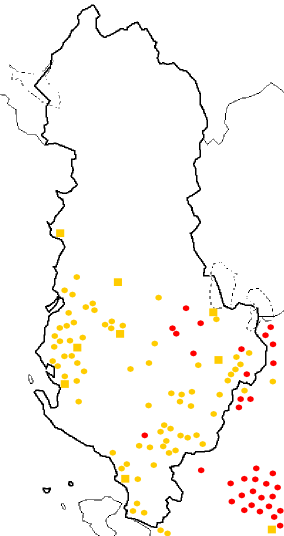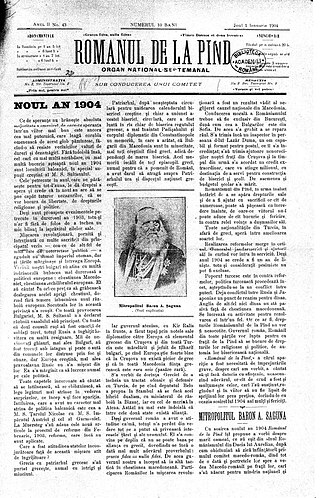| Part of a series on |
| Aromanians |
|---|
 |
This is a list in progress of world-famous or important Aromanians and people having Aromanian ancestry.
| Part of a series on |
| Aromanians |
|---|
 |
This is a list in progress of world-famous or important Aromanians and people having Aromanian ancestry.

The Aromanians are an ethnic group native to the southern Balkans who speak Aromanian, an Eastern Romance language. They traditionally live in central and southern Albania, south-western Bulgaria, northern and central Greece and North Macedonia, and can currently be found in central and southern Albania, south-western Bulgaria, south-western and eastern North Macedonia, northern and central Greece, southern Serbia and south-eastern Romania. An Aromanian diaspora living outside these places also exists. The Aromanians are known by several other names, such as "Vlachs" or "Macedo-Romanians".
The Megleno-Romanians, also known as Meglenites, Moglenite Vlachs or simply Vlachs, are an Eastern Romance ethnic group, originally inhabiting seven villages in the Moglena region spanning the Pella and Kilkis regional units of Central Macedonia, Greece, and one village, Huma, across the border in North Macedonia. These people live in an area of approximately 300 km2 in size. Unlike the Aromanians, the other Romance-speaking population in the same historic region, the Megleno-Romanians are traditionally sedentary agriculturalists, and not traditionally transhumants. Sometimes, the Megleno-Romanians are referred as "Macedo-Romanians" together with the Aromanians.

The Kruševo Republic was a short-lived political entity proclaimed in 1903 by rebels from the Secret Macedonian-Adrianople Revolutionary Organization (IMRO) in Kruševo during the anti-Ottoman Ilinden–Preobrazhenie Uprising.

The Macedonian Struggle was a series of social, political, cultural and military conflicts that were mainly fought between Greek and Bulgarian subjects who lived in Ottoman Macedonia between 1893 and 1912. The conflict was part of a wider guerilla war in which revolutionary organizations of Greeks, Bulgarians and Serbs all fought over Macedonia. Gradually the Greek and Bulgarian bands gained the upper hand. Though the conflict largely ceased by the Young Turk Revolution, it continued as a low intensity insurgency until the Balkan Wars.

Moscopole or Voskopoja is a village in Korçë County in southeastern Albania. During the 18th century, it was the cultural and commercial center of the Aromanians. At its peak, in the mid 18th century, it hosted the first printing house in the Ottoman Balkans outside Constantinople, educational institutions and numerous churches. It became a leading center of Greek culture but also with elements of Albanian and Aromanian culture, all with great influence from Western civilization.

Pitu Guli was an Aromanian revolutionary in Ottoman Macedonia, a local leader of what is commonly referred to as the Internal Macedonian Revolutionary Organization (IMRO).

Kruševo is a town in North Macedonia. In Macedonian the name means the 'place of pear trees'. It is the highest town in North Macedonia and one of the highest in the Balkans, situated at an altitude of over 1350 m above sea level. The town of Kruševo is the seat of Kruševo Municipality. It is located in the western part of the country, overlooking the region of Pelagonia, 33 and 53 km from the nearby cities of Prilep and Bitola, respectively.
There are several names of the Aromanians used throughout the Balkans, both autonyms and exonyms.
The Aromanians in North Macedonia, also known as the Vlachs, are an officially recognised minority group of North Macedonia numbering some 9,695 people according to the 2002 census. They are concentrated in Kruševo, Štip, Bitola and Skopje.

The Aromanian language, also known as Vlach or Macedo-Romanian, is an Eastern Romance language, similar to Megleno-Romanian, Istro-Romanian and Romanian, spoken in Southeastern Europe. Its speakers are called Aromanians or Vlachs.

Malovište is an Aromanian village in the municipality of Bitola, North Macedonia. It used to be part of the former municipality of Capari.

The Aromanians in Albania are an officially recognised ethnic minority in Albania.

The Aromanians in Greece are an Aromanian ethno-linguistic group native in Epirus, Thessaly and Western and Central Macedonia, in Greece.
The Ullah millet was a separate millet within the Ottoman Empire. It was established by the Ottoman authorities for the Aromanians in 1905, during the rise of nationalism in the Ottoman Empire. Although the Megleno-Romanians are also sometimes called Vlachs, the Ullah millet was not intended for them.
The Aromanians in Romania are a non-recognized ethnic minority in Romania that numbered around 26,500 people in 2006. Legally, Romania regards the Aromanians and other groups such as the Megleno-Romanians and the Istro-Romanians as part of the Romanian nation. This is according to a promulgated legislation according to which Romania supports the rights of all those who "assume a Romanian cultural identity, people of Romanian origin and persons that belong to the Romanian linguistic and cultural vein, Romanians who live outside Romania, regardless how they are called". Such is also the stance of the Romanian Academy.

Românul de la Pind was a Romanian weekly newspaper. It was founded on 26 May 1903 in Bucharest, Romania, by the Aromanian cultural activist Nicolae Constantin Batzaria, who was the director of the newspaper, in collaboration with several other Aromanian colleagues in the Ottoman Empire. Early issues of the newspaper carried the name Reforme, and were under the authorship of an anonymous committee. During this time, editors called for measures and reforms to take place for the protection of the supposedly Romanian minorities south of the Danube. As of issue 12, the newspaper began to be titled Românul de la Pind, revealing being led by intellectuals from the Ottoman Empire. In 1904, editors of the newspaper began to sign their articles, these including Batzaria himself, Aromanian writers Marcu Beza and Nicolae Velo and Aromanian professor Ion D. Arginteanu. Other editors of the newspaper throughout its existence were the Aromanian poet and author of the Aromanian anthem Constantin Belimace and the Megleno-Romanian editor and professor Constantin Noe. In 1906, Revista Macedoniei, newspaper in circulation from 25 September 1905 to 17 September 1906, was merged into Românul de la Pind. It was a weekly newspaper operated by the Macedo-Romanian Cultural Society. For a time, N. C. Furca succeeded Batzaria as the newspaper's director. Românul de la Pind ceased its publications on 25 November 1912 with the First Balkan War. It was the longest-running newspaper by and about Aromanians until the times of World War II.

Filip Mișea was an Aromanian activist, physician and politician. Mișea became an Ottoman deputy, with him and Nicolae Constantin Batzaria being the only Aromanians to ever enter the Ottoman parliament. He would later move to Romania and devote himself to medicine there.
Aromanian studies are an academic discipline centered on the study of the Aromanians. They are included within Balkan and Romance studies. Notable scholars on Aromanian topics include Matilda Caragiu Marioțeanu, Thede Kahl and Gustav Weigand. The Aromanian question, a term used for the historical and current division on ethnic identity among the Aromanians, has prominently influenced Aromanian studies.

Cola Nicea was an Ottoman-born Aromanian armatole revolutionary during the Macedonian Struggle. He was part of the first Aromanian band of the Internal Macedonian Revolutionary Organization (IMRO), leading it as voivode for a time. Once the conflicts in Macedonia ended, Nicea emigrated to Romania.

Ioryi Mucitano, nicknamed Kasapcheto ("Butcher"), was an Ottoman Aromanian revolutionary during the Macedonian Struggle. He was the first leader of the first Aromanian band of the Internal Macedonian Revolutionary Organization (IMRO).
цинцарска породица Грабован
Донка је имала рођаке међу Цинцарима у Зајечару, од којих је потицао и познати глумац Та- шко Начић
Ioannis Kolettis, a Hellenised Vlach.